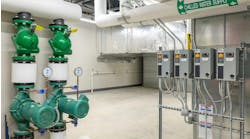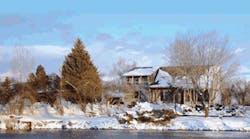Latest from Radiant
Sponsored
Katharine Hepburn and Henry Fonda they're not. But for Wendy and Tim Brockish, this tranquil, southeastern Idaho setting is the backdrop for an “On Golden Pond” movie if there ever was one. Their elegantly rustic home is near the joining of two creeks, forming a “slough” visited year-round by wildlife, including mule deer, coyote, trumpeter swans, eagles, beaver and an occasional moose.
But the couple's back-to-nature homestead had one key flaw. There in Rexburg, in the Snake River plain just to the west of the Rocky Mountains, Mother Nature takes off the kid gloves during the long winter season, generously doling out heavy snowfalls and brutally cold temperatures. It's enough to send newcomers to the area packing hastily for the next flight to Miami.
The couple's roots in Idaho go back to the mid-80s, so they weren't about to give up their dream of an idyllic home on the range. Tim grew up in Colorado, and Wendy was raised in Wisconsin. No strangers to winter conditions, they decided early on to make a go of it. “We've never regretted it,” Wendy said.
Thanks to geothermal HVAC and radiant heat, this couple - in no hurry to reach their golden years - can comfortably step into retirement whenever they decide to.
Mice like it too
When they bought the property in 1994, an old doublewide served as home for several years.
“We purchased eight acres and worked on the property routinely,” Tim said. “At night, we recall the sound of mice in the walls, so we weren't the only ones enjoying the location.”
Tim said in 2000, they purchased an adjacent 70-acre farm planned as an annex to their now-extensive water life rehabilitation effort (www.ouridaho.us). At about the same time, they removed the trailer and began construction of the home they now live in. Initially, the house had an electric furnace and pellet stove as the heat sources.
“We had sufficient space to have some 6-ft.-deep trenches dug for slinky-loop geo-exchange, so in 2002 we did that and upgraded the HVAC system to a ClimateMaster geothermal unit for heating and cooling,” Tim said. “We saw a big reduction in our energy bills, and the geothermal system has done very well for us over the years, especially in the summertime when it gets hot and humid.
“The system has added tremendously to the level of comfort we have at home. The only drawback to the forced air system was that we still had cold floors. That's what fueled our interest in radiant.”
Wendy said she spoke with her cousin, Contractor Magazine columnist Dave Yates, at a family reunion a few years ago about their interest in radiant heat.
“He was so eager to talk about it,” she said.
After the reunion and over a period of months, Yates educated them, mainly by email. This enabled Tim and Wendy to make some informed decisions about how to specify the type of radiant system they would want for their 2,200-sq.-ft., two-bedroom home.
Tim said groundwater at their property is reached at a depth of only 8 ft., so that eliminated the possibility of a basement. The house is constructed above a 3-ft. crawl space. It was in this area that Justin Johnson, owner of Idaho Falls, Idaho-based Sprinter Heating and Hydronics, and Todd Hamilton, senior technician, went to work last year to install a radiant heat system to serve as the home's new primary heat source.
Connected to the network of staple-up radiant heat tubing are mechanical systems they installed in a water heater closet, including a high efficiency, LP gas-fired condensing boiler and a wall-hung tankless water heater.
The space was vacated by an 80-gallon electric water heater removed by Johnson and Hamilton. Johnson designed and built a control panel using a simple microprocessor control and several Grundfos, multi-speed circulators. Nearby are the manifolds that supply the heat to the three-zone, eight-loop distribution system.
Multi-speed circulation
One of the most important facets to optimal circulation for hydronic systems is for contractors to match a pump's performance, or flow characteristics, to the specific job that it needs to perform within the system. A single-speed pump has one performance curve - a measurement of head (feet) and flow (gallons per minute) - and operates at that level only.
“But with the Grundfos SuperBrutes, we get a much broader range of performance,” Hamilton said. “With the flick of a switch, various speeds can be chosen, easily changing head and flow to meet the specific needs of the system.”
Two temperature zones were required because of the dissimilarity of the floor coverings on the first floor, which includes hardwood, vinyl and wall-to-wall carpet. By using RadiantWorks, Watts Radiant's system design software, the varying floor supply water temperatures were quickly matched with manifolds, loop lengths and flow rates.
The system that Johnson designed would call for multiple temperatures from a single temperature source.
“The Brockishes had set a fairly tight budget for the project, so I settled on a simple mixing strategy,” Johnson said. “A simpler-is-better approach not only saves money on the front end by reducing installation and material costs, (but) electrical costs are minimized, too. This is often ignored when systems are designed. A primary loop drives the heated water past two detours. If a heating cycle is activated, Btus are diverted to a three-way mixing, which then tempers the water as needed.”
About 2,200 lineal ft. of Watts Radiant EPDM “Onix” tubing was installed by Johnson for the home's staple-up radiant system, chosen because of the several advantages it offered.
“We like the material because of its excellent heat transfer when stapled-up,” Johnson said. “The tubing, by design, is slightly flattened against the underfloor when stapled into position. This greatly increases the surface area for contact with subfloor, moving heat out of the tubing and into the floor - without metal plates. Its rope-like flexibility gives it two other key advantages for a job like this.”
“It's easy to install,” Hamilton said, “so we spend a lot less time on the installation - unlike PEX, which has a mind of its own. And - most important for this job - Onix was the only tubing we could use to weave between the thousands of protruding metal nails driven through the subfloor when the home's hardwood flooring was applied.”
Uh-oh. Callback!
Johnson and Hamilton completed their radiant heat system work on a Friday. By Friday night, Tim knew that something was amiss. One of the three zone pumps was just pleasantly warm while the other two were toasty hot. The same was true for the three lines of tubing they fed. So he called Justin, who promised to be over the very next day.
“True to his word, by early Saturday afternoon Justin had it all sorted out,” Wendy said.
It turned out that a couple of wires were crossed. The bedroom and bathroom thermostats had each been sensing the other's assigned zone. As soon as Justin rewired them correctly, the bathroom began to warm.
And by Sunday morning … well, Wendy described it this way: “Yippee! Master bathroom bliss!”
It took only a week for Johnson and Hamilton to install the new heating system. But the response last winter was immediate.
In an email to Yates, Wendy told her cousin: “We are LOVING the radiant heat! I had to laugh when Tim said, as the beautiful snow was turning to slush and mud last weekend, ‘Now that we have radiant heat, I wish the winter would last longer!’ I'll second that! It's amazing how your perspective on the cold season changes.
“Another thing I've noticed - at the end of the work day, I find that my thoughts quickly turn to the happiness I feel when I arrive home and open the door to a cozy, warm, comfortable house. Ahh, how we do love living in a ‘rad pad.’ And Tim just reminded me to tell you how nice and quiet it is too.”
And in another message a few days later, Wendy wrote: “We're amazed at the comfort of warm floors. As proof of the value of this stuff, our ol' arthritic dog Luke (age 11) now lies sprawled on the warm floor (instead of balled up in his cozy crate), clearly soaking it up in great contentment. He sure seems pleased. Today he came along on a 5-mile bike ride, trotting comfortably the whole way - very significant for him.


